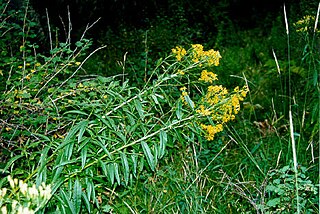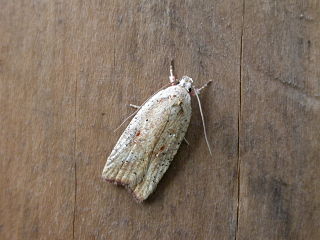| Agonopterix canadensis | |
|---|---|
 | |
| Scientific classification | |
| Kingdom: | |
| Phylum: | |
| Class: | |
| Order: | |
| Family: | |
| Genus: | |
| Species: | A. canadensis |
| Binomial name | |
| Agonopterix canadensis | |
| Synonyms | |
| |
Agonopterix canadensis, the Canadian agonopterix, is a moth of the family Depressariidae. It is found from the north-eastern United States and southern Canada, south through the Rocky Mountains to Colorado, the Basin Range and the mountains of central California and Nevada. [2]

Moths comprise a group of insects related to butterflies, belonging to the order Lepidoptera. Most lepidopterans are moths, and there are thought to be approximately 160,000 species of moth, many of which have yet to be described. Most species of moth are nocturnal, but there are also crepuscular and diurnal species.

Depressariidae is a family of moths. It has formerly been treated as a subfamily of Gelechiidae, but is now recognised as a separate family, comprising about 2300 species worldwide.

Canada is a country in the northern part of North America. Its ten provinces and three territories extend from the Atlantic to the Pacific and northward into the Arctic Ocean, covering 9.98 million square kilometres, making it the world's second-largest country by total area. Its southern border with the United States, stretching some 8,891 kilometres (5,525 mi), is the world's longest bi-national land border. Canada's capital is Ottawa, and its three largest metropolitan areas are Toronto, Montreal, and Vancouver.
The length of the forewings is 8.5-10.5 mm.
The larvae feed on Senecio species, including Senecio serra .

Senecio is a genus of the daisy family (Asteraceae) that includes ragworts and groundsels. The scientific Latin genus name, Senecio, means "old man."

Senecio serra is a species of flowering plant in the aster family known by the common names tall ragwort and sawtooth groundsel. It is native to the western United States, where it can be found in several types of habitat, including sagebrush and woodlands. It is a perennial herb producing a single erect stem or a cluster of stems from a branched, woody caudex. The plant can exceed two meters in height. It is hairless in texture, with young plants sometimes appearing fuzzy, and green to red-tinged in color. The leaves have lance-shaped blades up to 20 centimeters long borne on short petioles, the leaves occurring evenly all along the stems. The inflorescence is a spreading array of many flower heads, each lined with green- or black-tipped phyllaries. The heads contain yellow disc florets and 5 to 8 yellow ray florets each under a centimeter long.








